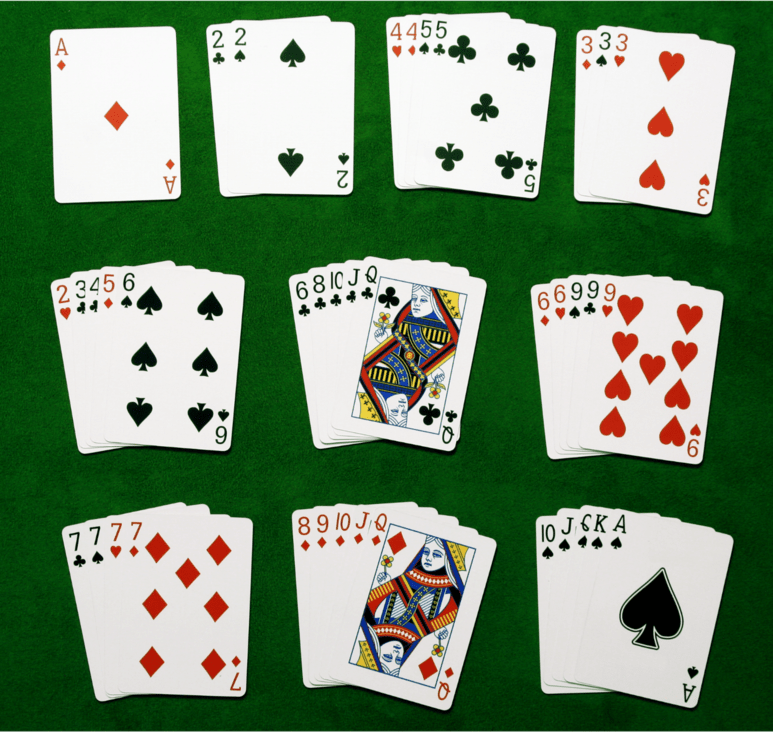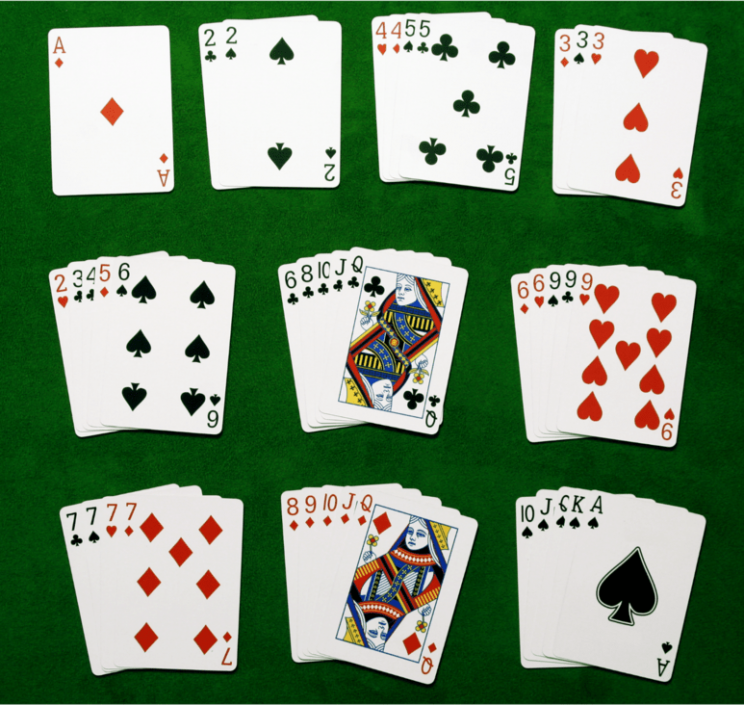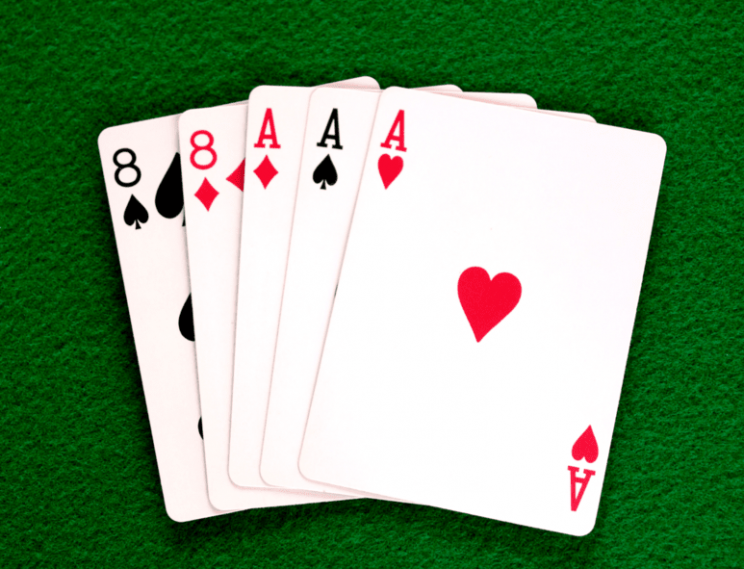
포커 핸드 랭킹 차트 (족보)
온라인 포커가 인기를 끌면서 전 세계 사람들이 포커를 더 쉽게 접할 수 있게 되었습니다. 실제 사람들이 실제 돈으로 플레이하며 경쟁하는 디지털 포커 테이블에서 단 몇 번의 클릭으로 게임을 즐길 수 있습니다.
또한, 포커에 대한 다양한 자료와 교육 콘텐츠가 점점 더 많아지고 있어 초보자는 수준급의 플레이어가 될 수 있고, 수준급 플레이어는 최고 수준에서 경쟁하는 세계적인 프로가 될 수 있습니다.
왜 포커를 시작해야 하나요?
포커는 플레이어 숫자뿐만 아니라 게임의 수준도 점점 성장하고 있습니다. 그 어느 때보다 흥미진진하고 경쟁이 치열해졌지만, 신규 플레이어와 아직 포커 실력을 시험해 보지 않은 플레이어는 이에 위축되지 않으셔도 됩니다. 포커를 플레이할 수 있는 웹사이트와 앱 선택의 폭이 그 어느 때보다 넓어졌기 때문에 누구나 자신의 경험과 게임에 대한 지식에 맞는 게임을 플레이할 수 있는 곳을 찾을 수 있습니다.
이는 완전 초보자도 마찬가지입니다. 포커는 이제 전 세계에서 즐거움과 함께 실질적인 보상을 가져다주는 게임으로 자리 잡았습니다. 그렇다면 이 게임의 규칙과 전략을 배우는 데 시간을 투자하는 것도 충분히 이해할 만한 일이겠죠. 하지만, 모든 시작에는 첫걸음이 필요합니다.
시작하기 가장 좋은 지점은 포커 핸드 랭킹에 익숙해지는 것입니다.

포커 족보
먼저, 오늘날 포커에는 수많은 변형이 존재한다는 사실을 알아두셔야 합니다. 말 그대로 셀 수 없이 많으므로 새로 등장하는 모든 변형을 일일이 파악하는 것은 불가능하며, 게임의 특성상 앞으로 점점 더 많은 변형을 만나게 될 것입니다.
또한, 모든 종류의 포커는 다양한 방식으로 플레이할 수 있으며, 플레이어가 가진 카드의 수나 제한, 게임 시작 전에 플레이어가 직접 결정할 수 있는 기타 가변적인 세부 사항 등 다양한 방식으로 플레이할 수 있습니다.
하지만 대부분의 변형 방식에서 같게 적용되는 것은 핸드 랭킹입니다. 또한, 대부분의 변형 게임에서 목표는 5장의 강력한 카드를 연결하는 것인데, 때로는 총 5장의 카드만 받기도 하고 7장, 8장 또는 그 이상을 받기도 하지만 가장 강력한 패를 연결할 수 있는 5장을 선택하는 것이 목표입니다.
이제 가장 강한 카드부터 가장 약한 카드까지 순위를 자세히 알아보세요.
로얄 플러시
포커에서 가장 강한 핸드는 로얄 플러시입니다. 이는 같은 수트에서 가장 높은 값의 카드 5장이 나오는 것을 의미합니다. 예를 들어 10♥, J♥, Q♥, K♥, A♥가 있으며, 4가지 수트가 있기 때문에 이 핸드를 뽑는 방법에는 단 4가지의 경우의 수가 있습니다.
포커에서 수트는 모두 동일한 가치를 가지므로 클럽, 하트, 다이아몬드 또는 스페이드 중 어떤 것이 나오든 상관없습니다. 그러나 4개의 로얄 플러시를 연결하는 것은 극히 드뭅니다.
5-카드 게임에서는 649,379:1의 확률로 로열 플러시가 나올 수 있고, 7-카드 게임(가장 인기 있는 포커 버전인 텍사스 홀덤 포함)에서는 30,939:1로 확률이 조금 높아지지만, 여전히 모든 종류의 포커에서 자주 볼 수 있는 핸드는 아닙니다.

스트레이트 플러시
스트레이트 플러시도 마찬가지로 맞추기 매우 어렵습니다. 스트레이트 플러시는 같은 수트의 카드 5장을 연속적으로 연결해야 하지만, 가장 높은 값의 카드 5장이어야 한다는 조건은 없습니다. 따라서 로열 플러시는 스트레이트 플러시의 가장 좋은 버전이라고 할 수 있습니다.
따라서 같은 수트의 카드 5장을 나란히 뽑으면 스트레이트 플러시입니다. 여기에는 3♦, 4♦, 5♦, 6♦, 7♦ 또는 8♠, 9♠, 10♠, J♠, Q♠와 같은 핸드가 포함됩니다.
하지만 두 명 이상의 플레이어가 스트레이트 플러시를 했다면 어떻게 될까요? 이 경우 가장 높은 카드를 가진 사람이 승자가 됩니다. 위의 두 가지 예시에서 다이아몬드 스트레이트 플러시는 7이 높은 카드이고 클럽 스트레이트 플러시는 Q가 높은 카드이므로 클럽 스트레이트 플러시를 가진 플레이어가 승자가 됩니다. 극히 드물지만, 두 명의 플레이어가 동일한 하이 카드로 스트레이트 플러시를 한 경우, 두 플레이어가 팟을 나눠 갖습니다.
포 오브 어 카인드
흔히 4개의 에이스가 포커에서 가장 강한 패라고 생각하지만, 실제로는 세 번째로 강력한 패입니다. 포 오브 어 카인은 간단히 말해 같은 등급의 카드 4장을 가지고 있다는 뜻입니다. 예를 들어 5♣, 5♠, 5♦, 5♥ 또는 6♣, 6♠, 6♦, 6♥ 등이 있습니다.
역시 두 명 이상의 플레이어가 같은 종류의 카드 4장을 모으면 타이브레이커는 해당 카드의 등급입니다. 따라서 6이 5를 이기고 Q가 J를 이기며 두 플레이어가 각각 같은 등급의 카드 4장을 얻을 수 있는 가능성은 없습니다. 만약 그런 일이 발생한다면 플레이 중인 덱이나 플레이어의 소매를 살펴보아야 합니다.
5장의 카드가 모두 사용되지 않은 첫 번째 패라는 것을 눈치챘을 수도 있습니다. 남은 카드와 연결되지 않은 카드를 ‘키커’라고 하며, 때에 따라서는 최종 타이 브레이커의 역할을 하지만 이에 대해서는 나중에 설명하겠습니다. 네 장으로 구성된 핸드에서 다섯 번째 카드는 전혀 관련이 없습니다.
풀 하우스
다음은 5장의 카드를 모두 사용해야 하는 또 다른 핸드인 풀 하우스입니다. 풀 하우스를 만들려면 같은 등급의 카드 3장과 같은 등급의 카드 2장을 합치면 되지만, 앞의 세 장과 같은 등급이 아니어야 합니다(어차피 불가능하죠). 풀 하우스를 만드는 방법은 다소 어렵게 들릴 수 있지만 실제로는 매우 간단합니다.
풀 하우스의 예로는 4♣, 4♠, 4♦, J♥, J♦ 또는 10♦, 10♠, 10♥, 7♣, 7♦가 있습니다. 여러 플레이어가 풀 하우스를 가지고 있는 경우, 먼저 누가 가장 높은 등급의 트립을 가지고 있는지 확인해야 합니다. 따라서 이 경우 10과 7을 가진 플레이어가 10이 4를 이기므로 승리합니다.
5 카드 게임에서는 두 플레이어가 동일한 트립을 가질 수 없지만, 카드가 더 많은 다른 변형 게임에서는 두 플레이어가 동일한 트리플로 풀 하우스를 가질 수 있습니다. 이 경우 남은 카드의 페어를 확인합니다. 플레이어 A가 8, 8, 8, 5, 5를 가지고 있고 플레이어 B가 8, 8, 8, K, K를 가지고 있는 경우 플레이어 B가 승리합니다.
심지어 풀 하우스를 가진 두 플레이어가 완전히 동일한 패를 가지고 있는 경우도 있습니다. 예를 들어 텍사스 홀덤에서는 플레이어 A와 B가 모두 포켓에 9를 가지고 있어 보드에 9, 9, 4, 4가 나올 수 있습니다. 이 경우 두 플레이어는 모두 9와 4로 풀 하우스를 가지고 있으므로 팟을 나누게 됩니다.

플러시
플러시와 스트레이트를 쉽게 기억하기 위해(스트레이트는 잠시 후에 설명하겠습니다), 스트레이트 플러시는 이 두 가지로 이루어진다는 점만 기억하세요. 첫 번째, 더 강한 패인 플러시는 같은 수트의 카드 5장을 의미합니다.
예를 들어 3♥, 5♥, 8♥, J♥, A♥와 2♠, 7♠, J♠, Q♠, K♠는 플러시가 됩니다. 마찬가지로 모든 수트의 강도는 동일합니다. 하지만 여러 플레이어가 플러시를 가지고 있는 경우 가장 높은 카드를 가진 플레이어가 승자가 됩니다. 따라서 위의 두 가지 예 중에서 하트의 플러시가 스페이드의 플러시를 이깁니다.
가장 높은 카드가 같은 경우, 타이 브레이커는 두 번째로 높은 카드입니다. 따라서 플레이어 A가 2, 6, 8, 10, Q를 들고 있고 플레이어 B가 3, 4, 6, 7, Q를 들고 있다면 10이 7을 이기므로 플레이어 A가 승리합니다. 두 번째로 높은 카드도 동일하다면 세 번째로 높은 카드를 보는 식으로 진행합니다.
두 플레이어가 정확히 같은 카드를 가지고 있다면, 팟은 두 플레이어가 나눠 갖습니다.
스트레이트
앞서 말씀드린 것처럼 스트레이트 플러시의 두 번째 구성 요소는 바로 스트레이트입니다. 스트레이트는 플레이어가 5장의 카드를 순서대로 배열된 아무 수트의 카드를 가지고 있을 때의 핸드입니다.
예를 들어, 플레이어가 3♥, 4♦, 5♥, 6♠, 7♣ 또는 10♠, J♣, Q♣, K♦, A♥를 가지고 있다면 스트레이트가 됩니다. 앞의 모든 예를 고려했을 때 타이 브레이커가 무엇인지 예상할 수 있습니다. 역시 가장 높은 카드입니다. 그렇기 때문에 위의 예시에서 승자는 에이스를 높은 카드로 가진 플레이어입니다. 가장 높은 카드가 같으면 다른 모든 카드도 반드시 같아야 하며 팟은 분할됩니다.
5 카드 게임에서 스트레이트가 나올 확률은 253:1입니다. 하지만 카드가 더 많은 변형 게임에서는 확률이 상당히 높아지며, 오마하 포커와 같은 일부 버전의 포커에서는 꽤 흔하게 나타날 수 있으며 플레이어의 전반적인 전략에 중요한 역할을 할 수 있습니다.

쓰리 오브 어 카인드
같은 등급의 카드 3장을 모으기만 하면 되는 매우 간단한 핸드입니다. 쓰리 오브 어 카인드의 카드는 8♠, 8♦, 8♥ 또는 A♦, A♣, A♠ 또는 이와 같은 종류의 카드입니다.
두 명 이상의 플레이어가 쓰리 오브 어 카인드를 가지고 있을 때 승자를 결정하는 규칙도 매우 단순하고 직관적입니다. 가장 높은 카드를 가진 플레이어가 승리합니다 – 위의 경우, 트리플 에이스가 트리플 8을 이깁니다.
쓰리 오브 어 카인드를 가진 플레이어는 3장의 카드와 상관없는 두 장의 카드를 가지고 있으며, 이 카드가 같은 등급의 쓰리 오브 어 카인드를 가진 플레이어들이 있으면 승자를 결정합니다. 앞서 살펴본 것처럼 이러한 조합에 상관없는 카드를 키커라고 하며, 승자를 결정짓는 중요한 요소입니다. 키커에 대한 자세한 설명은 곧 다룰 예정입니다.
투 페어
투 페어 역시 매우 간단한 개념입니다. 한 플레이어가 동일한 등급의 카드를 두 장 가지고 있으면 투 페어 핸드입니다. 물론, 이 두 쌍의 카드는 서로 달라야 합니다. 그렇지 않으면 포 오브 어 카인드 핸드가 됩니다.
여러 플레이어가 투 페어를 가지고 있으면, 승자를 결정하는 기준인 타이 브레이커는 하이 페어입니다. 이 예시에서 하이 페어는 7과 Q이며, Q를 가진 플레이어가 승리합니다.
두 플레이어가 같은 하이 페어를 가지고 있을 때마다 로우 페어를 확인합니다. 따라서 플레이어 A가 6, 6, J, J를 가지고 있고 플레이어 B가 10, 10, J, J를 가지고 있다면 플레이어 B가 팟을 가져갑니다. 두 플레이어가 같은 페어 카드를 가지고 있다면 남은 키커가 승자를 결정합니다.
원 페어
포커에서 가장 약한 패는 원 페어입니다. 4, 4, 7, 7, A, A 등 같은 등급의 카드 두 장은 모두 원 페어로 간주됩니다. 두 명 이상의 플레이어가 원 페어를 가지고 있으면, 가장 높은 등급의 페어를 가진 플레이어가 승리합니다.
5 카드 게임에서는 원 페어를 얻을 확률이 약 2.36:1로 상당히 높습니다. 재미있는 점은 카드 수가 많은 변형 게임에서는 일반적으로 핸드 조합을 만들지 못한 것보다 원 페어를 얻을 확률이 훨씬 더 높다는 것입니다.
하이 카드
그러나 플레이어가 말 그대로 아무 조합도 만들지 못한 때도 있습니다. 7 카드 게임에서는 이런 상황은 약 4.74번 중 한 번꼴로 일어나지만, 분명 일어날 수 있습니다. 그리고 나머지 모든 플레이어에게 이런 일이 생기면 가장 높은 카드를 가진 플레이어가 승자가 됩니다. 모든 플레이어가 같은 하이 카드를 가지고 있으면 두 번째로 높은 카드를 확인하고, 그래도 안 되면 세 번째로 높은 카드를 확인하는 식으로 진행합니다.
키커
마지막으로 최종 승부를 결정짓는 키커가 등장합니다. 키커는 핸드 조합과 상관없는 카드로, 다른 방법으로 승부를 결정할 수 없을 때 사용되며 기본적으로 하이 카드 규칙과 동일한 방식으로 작동합니다.
예를 들어 설명해 보겠습니다. 플레이어 A와 플레이어 B가 다음과 같은 패를 가지고 있다고 가정해 보겠습니다:
A: k, k♥, 7♦, 7♣, q♦
B: k♠, k♣, 7♥, 7♠, 5♠
보시다시피, 두 플레이어 모두 K 페어와 7 페어를 가지고 있으며 이를 구분할 방법이 없습니다. 이 경우, 더 높은 순위의 키커를 가진 플레이어, 즉 이 경우에는 키커로 Q를 가진 플레이어 A가 승자가 됩니다. 두 플레이어의 키커가 같았다면 두 플레이어가 팟을 나눴을 것입니다.
하지만 키커가 두 명 이상이면 상황이 조금 더 복잡해집니다. 가장 높은 키커가 동일한 경우, 두 번째로 높은 키커가 고려됩니다. 예를 들어
a: 9♠, 9♦, k♦, 10♠, 4♣
b: 9♣, 9♥, k♥, 8♦, 5♣
여기서 두 플레이어 모두 9와 K를 가장 높은 키커로 가지고 있지만, 플레이어 A가 두 번째로 높은 키커를 가지고 있기 때문에 팟을 가져갑니다. 물론 두 번째 키커가 같았다면 세 번째 키커가 승자를 결정하고, 두 플레이어의 핸드가 같으면 팟은 나눠집니다.
포커의 다른 랭킹 시스템
일부 변형 포커에는 대체 랭킹이 있지만, 일반적으로 앞서 설명한 랭킹 시스템에 기반합니다.
예를 들어, 로우볼 포커는 기본적으로 이 족보를 거꾸로 뒤집은 것입니다. 다양한 버전의 로우볼 포커에서 플레이어는 가능한 가장 약한 핸드를 가져야만 팟을 가져갈 수 있습니다. 구체적인 규칙과 세부 사항은 다를 수 있지만, 이것이 요점입니다.
가장 강한 패를 가진 플레이어가 팟의 절반을 가져가고 나머지 절반은 가장 약한 패를 가진 플레이어가 가져가는 하이-로우 시스템을 사용하는 변형된 포커도 있습니다. 이는 특히 오마하와 같이 선택할 수 있는 카드의 수가 많은 포커 버전에서 게임에 또 다른 차원을 더해줍니다.
앞으로의 글에서 이러한 대체 랭킹에 대해 더 많은 부분을 다룰 예정입니다.
이 글이 포커의 기본 원리를 이해하는 데 도움이 되셨기를 바라며, 이 아름다운 게임에 조금 더 가까워지는 시간이 되셨기를 바랍니다. 물론 포커에 완전히 익숙해진다는 것은 단순히 기본적인 족보를 배우는 것 이상의 의미가 있지만, 이 과정은 좋은 출발점이 될 것입니다.
포커의 매력에 흥미를 느꼈다면 더 깊이 파고들어 계속 학습하는 것이 좋으며, 이 과정에서 저희 블로그에 있는 자료를 활용할 수 있습니다.
게임을 차분히 공부하시고, 준비가 되었다고 느껴질 때 언제든지 코인포커에 가입해 직접 플레이를 시작해 보세요!
















